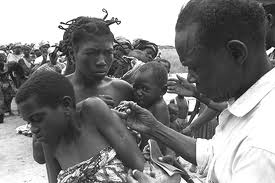The Global Eradication of Smallpox
D.A. Henderson, Karel Raška and The World Health Organisation 1979 (complete)
Projects involving the concerted global collaboration of more than fifty countries over many years are exceptionally rare, but in the 1960s and 70s one such project managed to produce one of the greatest achievements of mankind.

In 1966 the World Health Organisation formed the Smallpox Eradication Unit, an international team under the leadership of Donald Henderson with the goal of eradicating smallpox worldwide. There had been previous attempts at the control of smallpox, but nothing on this scale. The team focused first on greatly improving reporting of the disease using a disease surveillance methodology promoted by Karel Raška, which in turn enabled them to apply an innovative method known as "ring vaccination". Rather than vaccinating the whole populations of affected areas, the W.H.O. vaccinated in bands, surrounding broader populations affected by the disease. Since smallpox spreads from person to person, this effectively made boundaries that the disease could not cross.
Even with ring vaccination and improved delivery methods such as injector guns and improved needles, the logistical effort was immense. Many of the areas involved were remote and inaccessible and prone to armed conflict. The teams also had to deal with a number of natural disasters, particularly flooding. Large amounts of vaccine were required, this was initially donated by the USA and the USSR, but by the early 70s, more than half was produced in developing countries.
